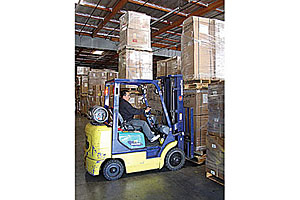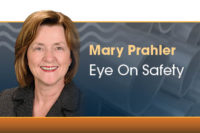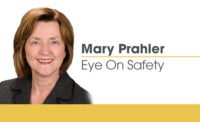
|
The forklift has been around for more than 100 years in one form or another, servicing the needs of every industry to manage the movement of all types of material.
They are a boon to industry, for sure, but there is another side to this successful innovation. A forklift also is one of the most significant hazards in the workplace for all employees who work with and around this type of equipment.
There are many statistical reports detailing fatalities and serious injuries, but the important fact is they all were avoidable. Some aspect of safety was neglected somewhere by someone. This could have been the operator, workers in the forklift operation area, a service technician, management or even the manufacturer. Anyone can figure out how to make a forklift move, but operating it properly and safely is another matter. So what are these aspects of forklift safety?
Hazard assessment of the workplace that utilizes forklifts is the first step. Identify and communicate to workers all hazards they are exposed to while performing their work with or around this equipment.
Training is one of the cornerstones on which to build a forklift safety program.
Safe job procedures identify the steps to safely perform a task with a forklift from start to finish. Operator inspection of the forklift, locking out and tagging defective equipment, and reporting deficiencies are the necessary first steps.
Non-operator awareness training is essential for folks who do not operate a forklift, but could encounter one in the workplace. What does the operator do at these times or more importantly, what do these people do? Do they appreciate the hazard they are exposed to if they do not ensure the operator sees them before they proceed?
Servicing and preventative maintenance inspections are not just filler for the operator manual. They are important steps identified by the manufacturer to keep the equipment in a safe operating condition. Having the brakes checked, damaged wheels replaced and hydraulic leaks repaired eliminate the additional hazard of having unsafe equipment in the workplace. Periodic inspection by a certified service technician is a critical management responsibility.
Equipment capabilities should be predetermined for the work to be done to ensure the right equipment is available. Attempting a lift of 4,000 lb. with a 3500-lb. machine from a 4-ft. deck or picking up a 72-in. load with 42-in. forks is work that shouldn’t exist if management has done its due diligence. A competent operator would know this and refuse to do the work.
Battery servicing for electric units adds a whole new dimension to the forklift hazard. Manually handling this extremely heavy item, sulfuric acid, explosive gases and electrical arcing are just a few serious issues that individuals are exposed to.
Each aspect of safety is deserving of its own article as there is much involved to ensure each is done right, which also means done safely. All are factors in the safety equation, but the most important is management’s responsibility to fully support the forklift program and to take a firm position for acts of noncompliance.
When it comes to forklift safety, we may have an opportunity to fix a deficiency in the safety program, but it could be too late for workers who become victims because of it.
Author bio: Peter Wright, CRSP, CET, is health, safety and environmental manager for CenturyVallen/Texcan. He can be reached at peter.wright@sonepar.ca or 780/490-2714. Eye on Safety is produced by the ASA Safety Committee. For more information, visit www.asa.net/safety.




